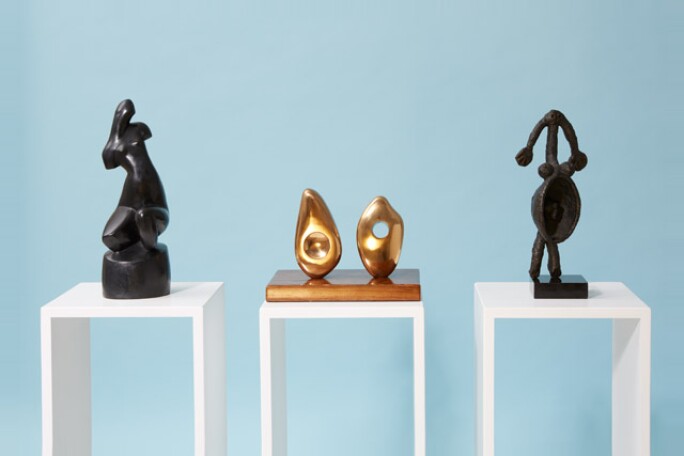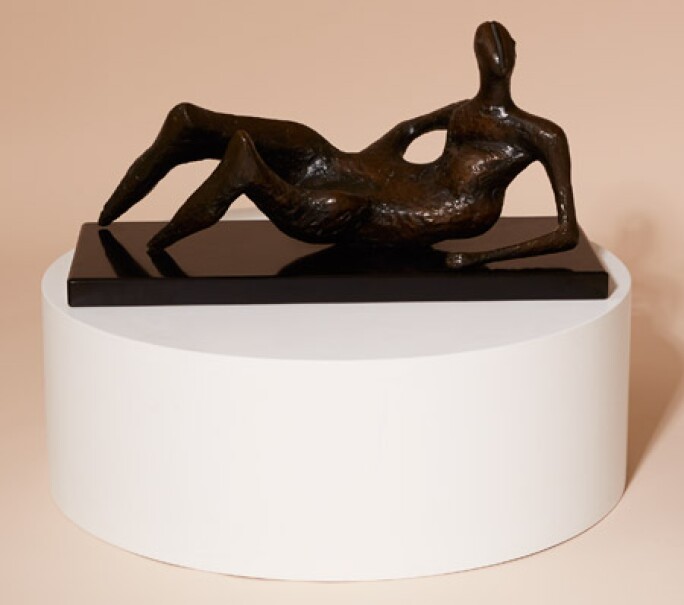T he upcoming Impressionist & Modern Art Day Sale, taking place on 22 June 2017 is led by an outstanding group of sculptural works from an important private collection, including works by Henry Moore, Barbara Hepworth, Alberto Giacometti, Jean Arp, Henri Laurens, Jean Dubuffet and Alexander Calder.
Mary and George Bloch enjoyed some 40 years of happy and informed collecting together, guided by a taste for graceful lines and exceptional materials and the visions of some of the world’s finest artists and craftsmen. There was also a touch of serendipity to their adventure. From the late 1960s through to the late 2000s the couple formed several collections of importance, including a world-renowned collection of Chinese snuff bottles and assemblages of Southeast Asian art, Japanese ivory and lacquer, Old Master prints and 20th-century Western art. In fact, some of the works in the present group of Modern and Contemporary sculptures, were bought in the first years of their marriage, and represent the couple’s early steps as collectors.
Included in this ensemble are important pieces by, among others, Henry Moore, Barbara Hepworth, Pablo Picasso, Joan Miró, Jean Dubuffet, Alexander Calder, Alberto Giacometti, Henri Laurens, Barry Flanagan, Jean Arp, Germaine Richier and Ju Ming. The collection represent the full sweep of 20th-century sculpture, encompassing figurative and abstract work, the diverse approaches of male and female artists, and disparate geographical origins (from Taiwan to Cornwall to the Côte d'Azur).
This intriguing line ties together European Modernism (Picasso, Giacometti), the height of post-war British art (Moore, Hepworth), the roots of Cubism (Laurens, Archipenko) and kinetic experimentation (Calder). However, while innovation and technical expertise are present in these works it is in their gathering that another, more personal, narrative is written.
“The artist has created and now it is left to the collector to assemble,” George remarked in 1986, shortly before many of these works were exhibited at the Hong Kong Museum of Art. “Mary and I had no definite assembly criteria in mind. Our only requirement, from the outset, was that we both had to love the object.” That they loved the same things was serendipitous.
And that love could go to great lengths. There is a story, surely too delightful to be false, that at one auction George was bidding on a lot when he noticed that the other bidder was the lady sitting in front of him. Tapping her on the shoulder he explained that Mary really wanted the work. Elizabeth Taylor turned around and smiled at George. She promptly stopped bidding.
George Bloch was born in Vienna in 1920 into a family of respected Austrian industrialists. He was schooled in England – as a boy he would enjoy visits to the British Museum – but due to the Anschluss his family fled Austria in the late 1930s and resettled in Shanghai. Later, he built up a hugely successful business in Hong Kong, manufacturing housewares and computer parts and importing and distributing timepieces.
In 1969 he married Mary, who was born in Tianjin, the daughter of White Russian émigrés. It was a meeting of minds: George had already formed a major collection of stamps and Mary, who was fluent in Mandarin Chinese, had been surrounded by Chinese culture all her life. Art was therefore a strong bond for the newlyweds. They settled into a pattern of searching out works, at auctions and through trusted galleries, such as Perls Galleries in New York and Waddington Galleries in London.
They made a close friend in the renowned art dealer Leslie Waddington. “They were clients of Leslie’s for as long as I can remember,” recalled Clodagh Waddington, Leslie’s widow. “George and Mary were amazingly knowledgeable and enthusiastic collectors and covered so many different fields of collecting.” The two couples often met together in London, Italy and Hong Kong. “It was always a joy. Conversation over the dinner table was intellectually stimulating and great fun and browsing through their homes was a fascinating and educational experience.”
The Blochs were indeed committed autodidacts. “Mary used every free moment to visit museums and galleries in the cities where business took me,” noted George. “We attended lectures in museums in the evenings and during weekends and above all kept reading books.” Their collecting activities gave them the opportunity to meet artists in Britain, America, France and Italy. Mary also became a valued member of the Peggy Guggenheim Advisory Board in Venice.
They were, perhaps, best known for their enthusiastic pursuit of Chinese snuff bottles - the Asian equivalent of the gentlemen’s snuffboxes so popular in the West. Originally numbered at over 1,700 bottles, the collection has been extensively published and exhibited at museums in both Hong Kong and London, a city that the couple called their second home.
George insisted that there was no “compulsive thread” running through their collection: they bought the work of both young artists and established artists and “placed on ourselves no regional or cultural restrictions”. And yet themes do emerge, aspects to which Mary and George were consistently drawn. Perhaps most prominent is a Modernist approach to figurative art. Sometimes this is sensual - Laurens’ L’Automne and Archipenko’s Seated Black Torso – other times it is amorphous, as in the works by Moore and Dubuffet. Meanwhile, the body, as seen by Giacometti, Richier and Flanagan, is a malleable subject.
And where abstraction comes to the fore, as with Hepworth’s Four-Square (Four Circles) and Calder’s Double Helix – it is tempered by organic curves and swirls. “A sculptor is a person who is interested in the shape of things,” observed Henry Moore. Collectors can share in that fascination.
Curiously, the Modern shapes created by Moore, Miró, Dubuffet and the other artists represented here, often reflect the elegant forms featured in the couple’s Qing dynasty bottles. There is an eye for beauty certainly, but also for the playful. Ju Ming’s Taichi Sculpture draws a smile; as did the Bloch’s “resting pig” snuff bottle (with its plump amber snout). And both collections illustrate a fondness for tactile mediums.
After George’s passing in 2009, Mary decided that parts of their various collections should be dispersed in accordance with the plans they had agreed long before his illness. In recent years, Sotheby’s has staged a series of hugely successful sales of their snuff bottles.
“Every art collector knows that he or she is only the temporary trustee of the objects that form their collection,” George once observed. “Sooner or later the cycle recommences and the art objects pass again into other hands.” Let us hope that the new trustees of these sculptures will be blessed with the same serendipity so enjoyed by Mary and George.






